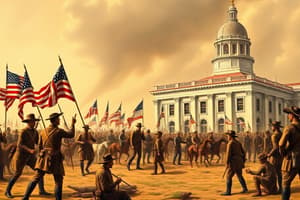Podcast
Questions and Answers
Which of the following events marked an expansion of U.S. territory during the early 19th century?
Which of the following events marked an expansion of U.S. territory during the early 19th century?
- Nullification Crisis
- Dred Scott Decision
- Adams-Onis Treaty (correct)
- Missouri Compromise
What was a significant outcome of the Supreme Court case Marbury v. Madison?
What was a significant outcome of the Supreme Court case Marbury v. Madison?
- Supported the legality of the Bank of the United States.
- Established the precedent of judicial review. (correct)
- Affirmed state sovereignty over federal law.
- Challenged the constitutionality of the Missouri Compromise.
Which amendment abolished slavery in the United States?
Which amendment abolished slavery in the United States?
- 13th Amendment (correct)
- 15th Amendment
- 12th Amendment
- 14th Amendment
The Ghost Dance was a religious movement associated with which of the following?
The Ghost Dance was a religious movement associated with which of the following?
Which legislation is associated with the concept of 'popular sovereignty' regarding the status of slavery in new territories?
Which legislation is associated with the concept of 'popular sovereignty' regarding the status of slavery in new territories?
What was one key factor leading to the outbreak of the Civil War?
What was one key factor leading to the outbreak of the Civil War?
Which of the following was NOT a consequence of the Reconstruction era?
Which of the following was NOT a consequence of the Reconstruction era?
Which conflict is associated with John Brown's raid on Harpers Ferry?
Which conflict is associated with John Brown's raid on Harpers Ferry?
Flashcards
Popular Sovereignty
Popular Sovereignty
The principle that the people of a territory should decide whether to allow slavery or not.
Raid on Harpers Ferry
Raid on Harpers Ferry
An event where a group of abolitionists attempted to start a slave rebellion by seizing the federal armory at Harpers Ferry.
Dred Scott Decision
Dred Scott Decision
The legal doctrine that declared African Americans, whether free or enslaved, were not considered citizens and had no right to sue in federal court.
Lincoln-Douglas Debates
Lincoln-Douglas Debates
Signup and view all the flashcards
Black Codes
Black Codes
Signup and view all the flashcards
Reconstruction
Reconstruction
Signup and view all the flashcards
Monroe Doctrine
Monroe Doctrine
Signup and view all the flashcards
Jim Crow
Jim Crow
Signup and view all the flashcards
Study Notes
Unit 4: 1800-1848
- Key events and figures of the early 19th century, including the Adams-Onis Treaty, the Abolition Movement, the Bank of the United States, and the American System.
- The Era of Good Feelings, the Embargo Act, the Factory System, and the Gibbons v. Ogden case.
- Key Supreme Court decisions, like the Marshall Court and the McCullough v. Maryland case.
- Conflicts contributing to sectionalism, exemplified by the Missouri Compromise, the Monroe Doctrine, the Nullification Crisis, and the Panic of 1837.
- Key figures and events shaping this era, including Henry Clay, John C. Calhoun, and Andrew Jackson.
Unit 5: 1848-1877
- The Civil War, encompassing the advantages/disadvantages of each side, events like Bleeding Kansas, the Emancipation Proclamation, and significant battles and figures.
- Reconstruction after the Civil War, including the Civil War Amendments (13-15), Congressional Reconstruction, the Compromise of 1877, and the decisions of the Dred Scott Supreme Court case.
- Key figures and events of the period, like John Brown, the election and actions of Abraham Lincoln, and the impact of the Kansas-Nebraska Act.
Unit 6: 1877-1900
- Post-Civil War developments into the early 20th century, encompassing figures like Booker T. Washington, WEB Du Bois, and the "New South" movement.
- The Jim Crow era, including segregation, disenfranchisement, and its impact on different groups, as well as the development of Black Codes.
- Key figures, historical contexts, and social movements concerning American Indians, such as the Ghost Dance and the Indian Wars, including the Battle of Little Bighorn.
- Other significant historical developments of the era, including the westward expansion, and the roles of farmers, miners, and ranchers.
Studying That Suits You
Use AI to generate personalized quizzes and flashcards to suit your learning preferences.




